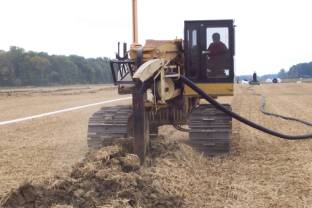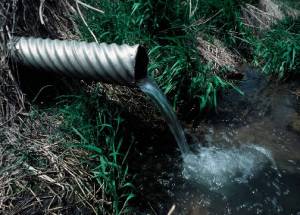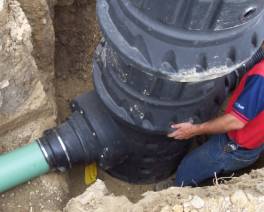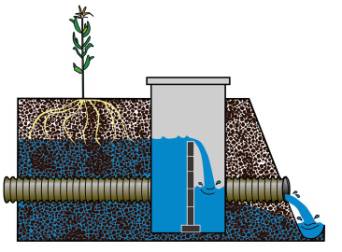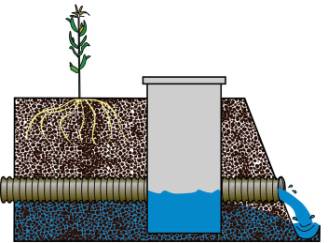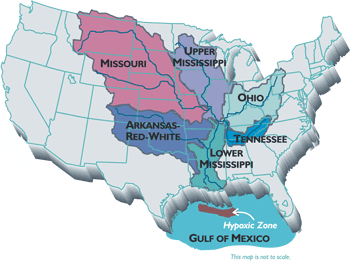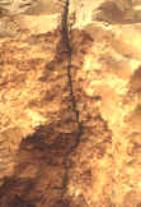MANAGED DRAINAGE FOR HIGHER
YIELDS:
|
||||||||||||||||||||||||
INTRODUCTION The installation of subsurface tile drainage that made millions of Midwest acres more productive is one of the great success stories of American agriculture. About half of Indiana farm ground benefits from subsurface drainage. And with the common use of yield monitors and yield mapping in the past decade, farmers were able to better quantify the impact of field drainage, renewing interest in field tile installation (Figure 1). Unfortunately, it’s been shown that field tiles emptying into streams (Figure 2) are a major source of excessive nitrogen and other plant nutrients in those streams, a growing environmental concern. Also, whereas field tiles provide a big benefit by removing excess water, retaining some of that water for crop use may be beneficial some years. A relatively simple solution addressing both of these concerns is to control the outflow of tiles by the use of water control structures.
Figure 1. Installing perforated plastic drainage tile in an Indiana field (Jason Brown).
Figure 2. A subsurface field tile draining into a Midwest stream (NRCS). |
||||||||||||||||||||||||
HOW DO CONTROL STRUCTURES WORK? There are different types of structures available to control the water flowing out of a field tile. One type uses a float that opens and closes a valve (Figure 3); another is a box containing removable boards (Figures 4 and 5). Note that the tile is not plugged, but the level of the water table is adjusted up or down by the addition or removal of boards that span the structure. The boards are stacked on their sides and fit into slots along the sides of the structure.
Figure 3. Float-type control structure being installed on an Indiana farm (Jason Brown).Control structures are most suited to fields that are level or nearly level, where slopes don’t exceed 1%. One control structure might be able to regulate the water table within 1 to 2 feet in a nearly level field as large as 20 acres. As slopes increase, more and more control structures are needed to properly regulate water levels across fields. Also, fields that have a pattern tile system are better suited, as you can have a greater area of impact across the field.
For controlling nitrogen pollution the most important factor is the amount of water leaving the field, but for crop management the most important factor is the depth of the water table below the field surface. As a general practice with managed drainage, the water table is lowered in preparation for spring planting and fall harvesting operations, and then is allowed to increase in the winter and summer. Table 1 shows a simplified scheme for how a field might be managed. Table 1. Managed drainage tile outflow and water table management scheme.
The above management scheme can be modified as conditions warrant. For example, if spring conditions are extremely dry, a grower may want to leave the boards installed to retain more water for later crop use. Or, if summer conditions turn out excessively wet, a grower may want to remove boards to further lower the water table. Furthermore, some growers have taken this scheme a step further and use the system for subirrigation. If an abundant water source is available, water can be added back into the system for summer crop needs. For subirrigation to work, there are limitations on how deep and how far apart tiles are spaced, as well as on the permeability of the underlying material. Tiles need to be close enough to corn roots to serve as a source of water. And, if subsoils are too permeable, added water will be lost to deeper layers. |
||||||||||||||||||||||||
DRAINAGE AND NITROGEN Less than 50 years ago corn was generally grown in a rotation with cereal crops and forage legumes such as alfalfa, red clover, and sweet clover. Through biological N fixation, the legumes provided residual N in the soil profile. In addition, most farms were using animal manures to supplement the nutrient needs of the crop. Today, most Midwest farmers employ a much less diverse crop rotation. Livestock operations are concentrated, meaning most farms supply crop nutrient needs largely through commercial fertilizers, not animal manure. Commercial nitrogen has been relatively inexpensive, with economic (and visual) penalties much greater for running short than applying too much, resulting in applications often exceeding crop utilization. Compared to past years there’s more nitrogen in the soil profile, and more is in the inorganic form, which is more susceptible to leaching. Farm tiles empty into drainage ditches and streams, and have been found to be a major source of the increasing nitrogen levels found in these watercourses. Subsurface drains enhance nutrient leaching of the soil profile. Nitrate concentrations coming from tile drains across the Midwest vary according to soil organic matter, crops and yields, yearly weather variation, fertilizer rates and timing, tile spacing, and the level of the water table. Nitrate loads from the Mississippi River to the Gulf of Mexico have increased 300% since 1970, and non-point sources have contributed most of the load. More than a million tons of nitrogen makes its way to the Gulf via the Mississippi River each year. Nitrate over-enrichment has been shown to contribute to hypoxia (low oxygen levels) and influences fish populations in the Northern part of the Gulf of Mexico (Figure 6). In fact, the Gulf of Mexico hypoxic zone is the second largest area of oxygen depleted waters in the world, and appears to be growing. The vast majority of the Gulf's commercial fishery landings come from the area directly affected by the Mississippi River.
Figure 6. The hypoxia zone, and the major rivers that influence the Mississippi River watershed (EPA).The reason hypoxia occurs is that elevated nitrate concentrations increase the growth of algae. Eventually the algae die, consuming oxygen as they decompose. The reduced oxygen level can have a significant impact on the populations of shrimp and many other marine organisms. Elevated nitrate levels in local streams have not been considered a major problem for most Midwest water uses. However, new surface water nutrient criteria being proposed for each EPA ecoregion may increase nitrate concerns at a local level. These proposed criteria are 75% lower than current nitrate levels typical in many streams draining agricultural areas. Once new nutrient standards are implemented, many water bodies will fail to meet the criteria and will be listed as impaired, eventually requiring a Total Maximum Daily Load (TMDL). Widespread implementation of TMDLs for nitrogen will increase the local demand for agricultural management practices that can substantially reduce nitrate loads going into surface water. Controlling tile outflows and soil water tables may be part of the answer to reducing stream loads of nitrogen. Having a higher water table through managed drainage means that there is a greater anaerobic volume in the soil to enhance denitrification, there is less tile water exiting the system, and there is less of a soil profile that water moves through to leach. In one eastern Illinois watershed, it has been estimated that stream nitrate concentrations could be reduced by 35% if half of the land in the watershed utilized managed drainage. |
||||||||||||||||||||||||
MANAGED DRAINAGE AND SOIL PROPERTIES Reducing tile flow and maintaining the water table at a higher level during certain times of the year is bound to have an impact on many soil characteristics and subsequent crop responses. Many of these characteristics remain untested, especially among unique soil types and in regions with different crops, rainfall, and soil evaporation/plant transpiration. In some peat soils, drainage has caused these soils to subside or settle at a rapid rate. Raising the water table certain times of the year can reduce oxidation in the soil profile, leading to preservation of the soil itself. Also, a higher water table means that lower soil layers contain more water, keeping them more buoyant under field traffic and less susceptible to compacting, minimizing settling. Past studies have shown soil physical properties can be improved by drainage, raising the question as to whether keeping a higher water table in place for prolonged periods might be harmful to soil properties. In one study, there were fewer soil macropores when the water table was maintained at a higher level. Earthworms improve soil physical properties, water infiltration, and drainage. Many farmers are concerned that maintaining higher water tables might have serious negative effects on earthworm populations (Figure 7), but at this time there’s not been enough research to evaluate the effects. Figure 7. Earthworm burrows may extend several feet down into the soil profile (USDA). |
||||||||||||||||||||||||
MANAGED DRAINAGE AND YIELD Introductory soils courses teach that subsurface tile drains remove gravitational water. With the water remaining held by capillary and hygroscopic forces, a soil is said to be at “field capacity”. Soils at field capacity contain a mix of water, air, mineral, and organic matter that is conducive to good plant growth. While field capacity soils are probably close to an ideal moisture status, all fields will experience a range of soil moisture, and water added by precipitation will constantly change the situation. The benefits of storing water to have it available if conditions turn dry in the summer will need to be weighed against any possible detrimental effects of a higher water table and a wetter soil profile earlier in the season. What will be the effects of field operations such as tillage where the water table may be higher? Will the shallower crop rooting that may occur with a higher water table actually lead to greater moisture stress when conditions turn drier? Also, if there is less N leaving the system by leaching, it reasons that there might be more available for plant growth. Opposing this, though, is that higher water tables may cause more nitrogen loss lower in the soil profile through denitritication. Although studies combining managed drainage with subirrigation have shown impressive yield responses, few researchers have measured yield changes with managed drainage alone (without subirrigation also). In North Carolina and Louisiana studies, the measured yield differences were inconsequential. In central Illinois in 2003, nine of 15 farmers said they had higher yields with drainage management. More research is needed to better quantify yield effects. |
||||||||||||||||||||||||
RETURNS FOR MANAGED DRAINAGE Managed drainage will be most readily adopted by farmers if it is profitable, that is if it increases yields, decreases costs, or if it reduces risk. Installing the control structures to manage drainage will add expense, as will the time and effort to manage them throughout the year. Thus, to be profitable, the value of additional yields produced with managed drainage must be greater than the costs to install and manage the structures. Cost-share funding may be available for managed drainage. In Indiana, the USDA NRCS Environmental Quality Incentives Program (EQIP) may provide funding for Practice Standard 554, Drainage Water Management and Practice Standard 587, Structure for Water Control. For more information, talk with your local District Conservationist. The first step in economic analysis is usually a partial budget. The increased costs are subtracted from the increased benefits. The example calculations below can help you decide the profitability for your own situation. The calculations assume:
Change the entries in the yellow boxes to recalculate the worksheet. First, enter the portions of your field where drainage can be managed, and estimate the potential yield benefits for corn and soybeans under drainage management. Economic assessments are based on the following assumptions:
Using default values, the example shown in Tables 2, 3, and 4 has controlled drainage installed on 15 acres in a 100 acre field, with a 15 bushel per acre corn yield increase and a 5 bushel per acre soybean yield increase. This is roughly a 10% yield increase on the area affected by the controlled drainage or an about 1% overall increase for the field. The structure cost calculations in Table 2 assume that the control structure and installation cost about $1000, that the useful life of the structure is 20 years and that the cost of capital is 10%. Using straight line depreciation and an interest charge on the initial investment, the annual cost for the field is about $150 ($1000/100 + $1000*0.1) and the cost per managed drainage acre is about $1.50. Table 3 contains the partial budget comparing the change in cost and the change in the value of yield. At $2/bu. corn and $5/bu. soybeans, average whole field crop value for a corn soybean rotation is increased by about $412.50 annually. Deducting the cost of labor for managing drainage, maintaining soil fertility, and extra drying and hauling, the whole field return over variable costs is increased by about $257. This is more than enough to cover the annual cost of the structure. Benefit is estimated as about $7 per managed acre or about $1 per acre for the whole field. RECALCULATION: Interactive Worksheets
| ||||||||||||||||||||||||
SUMMARY Subsurface tile drains have brought millions of acres of otherwise unfarmable land into production, but are also partially responsible for polluting streams with nitrogen and other nutrients. Managed drainage is a concept where tile flow is regulated by installing structures along tile lines to periodically raise the water table in the field. For most agricultural situations, water would be allowed to drain from the field in the spring and fall to allow field operations, and then be held back in the winter to minimize nitrogen leaching, and held in the summer to keep more water for crop use. Limited indications show that managed drainage has the potential to boost crop yields, especially in drier years, and thereby increase profits. Many other effects need further study, including the effect of a raised water table on soil properties, earthworms, and on various soil types and cropping systems. FOR MORE INFORMATION Drainage water management is a new practice in Indiana, and many questions still need to be answered. For more information, contact the following resource people, or visit the web sites listed. USDA Natural Resources Conservation Service Drainage Water Management conservation practice standard for Indiana: http://efotg.nrcs.usda.gov/references/public/IN/drainage_water_mgt.pdf Structure for Water Control conservation practice standard for Indiana http://efotg.nrcs.usda.gov/references/public/IN/structure_for_water_control.pdf Purdue University http://www.ecn.purdue.edu/safewater/Drainage/ University of Minnesota drainage web site http://d-outlet.coafes.umn.edu/ The Ohio State University’s Agricultural Drainage Water Management Web sites http://www.ag.ohio-state.edu/~agwatmgt Agricultural Drainage Management Systems Task Force http://www.ag.ohio-state.edu/~usdasdru/ADMS/ADMSindex.htm |

Table of Contents


- Pre-Test/Learning Objectives
- Introduction
- Control Structures
- Drainage and Nitrogen
- Managed Drainage and Soil Properties
- Managed Drainage and Yield
- Returns for Managed Drainage
- Summary
- Link to Quiz PDF
